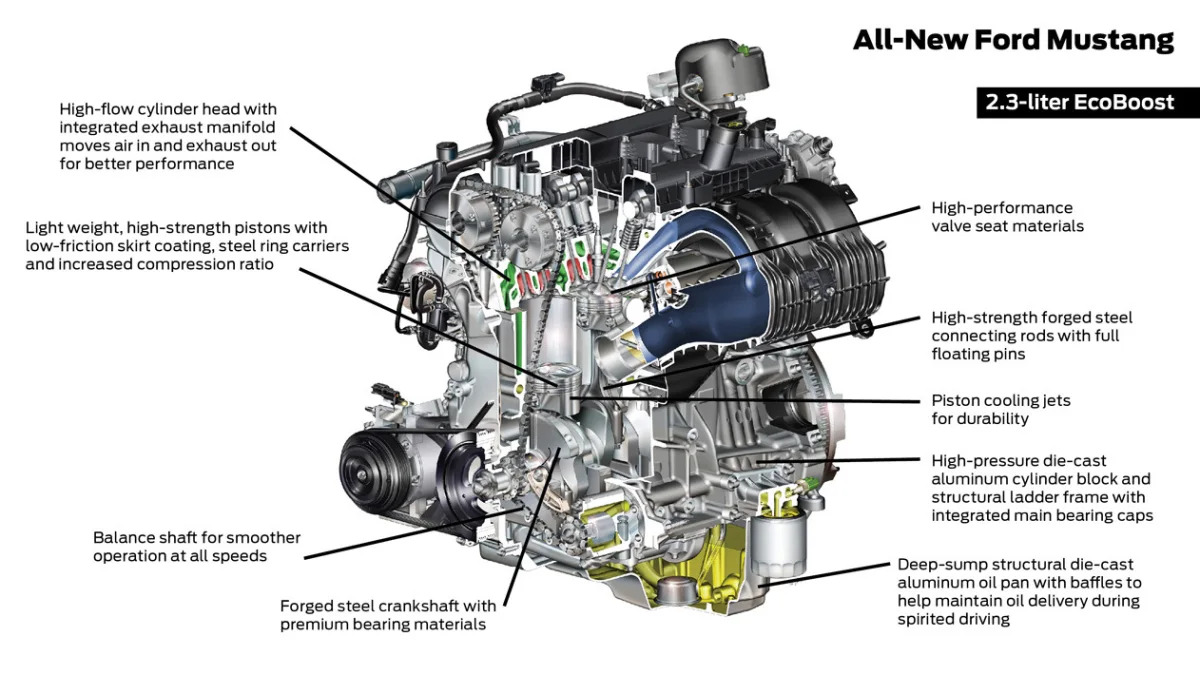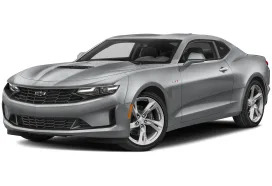Happy Mustang Day. Are you tired of hearing about the 2015 Ford Mustang yet? No? Good, here's a bunch of mechanical data on Ford's sixth-gen muscle car, along with cutaways of the GT's 5.0-liter V8 and the new 2.3-liter, EcoBoost four-cylinder shown above. We also have a smattering of info on the Stang's updated transmissions and an exploded-parts-diagram view of its all-new independent rear suspension.
Ford is set to make waves offering the Mustang with a turbo for the first time since the small-volume SVO of the 1980s. Displacing 2.3 liters, the engine's twin-scroll turbo should help the four-cylinder turn out a projected 305 horsepower and 300 pound-feet of torque, while also returning the best fuel economy in the Mustang's engine lineup. As we said in our Deep Dive, the EcoBoost will be slotted in as a premium engine, above the 3.7-liter V6 but below the 5.0-liter V8.
Speaking of that high-revving eight-cylinder, it's receiving a new cylinder head with high-flow ports. The intake and exhaust valves are larger and the cams have been replaced, among other tweaks. It should rev even higher thanks to a rebalanced crankshaft and forged connecting rods. Ford is still claiming a projected 420 hp and 390 lb-ft, although as many of the changes for the 2015's V8 come from the 2013 Boss 302, we're going to assume there's some sandbagging at work.
Finally, the transmissions have received some attention, with the six-speed manual from Getrag getting a new shift linkage, which should provide a shorter, crisper action. A new set of steering-wheel-mounted paddles on the auto trans will provide rev-matched shifts, although there's no word on how quickly it will swap cogs.
Check out the cutaways and exploded-parts-diagram views of the 2015 Mustang's mechanicals in our gallery. You can also scroll down for our gallery of launch images and a press release from Ford.
Ford is set to make waves offering the Mustang with a turbo for the first time since the small-volume SVO of the 1980s. Displacing 2.3 liters, the engine's twin-scroll turbo should help the four-cylinder turn out a projected 305 horsepower and 300 pound-feet of torque, while also returning the best fuel economy in the Mustang's engine lineup. As we said in our Deep Dive, the EcoBoost will be slotted in as a premium engine, above the 3.7-liter V6 but below the 5.0-liter V8.
Speaking of that high-revving eight-cylinder, it's receiving a new cylinder head with high-flow ports. The intake and exhaust valves are larger and the cams have been replaced, among other tweaks. It should rev even higher thanks to a rebalanced crankshaft and forged connecting rods. Ford is still claiming a projected 420 hp and 390 lb-ft, although as many of the changes for the 2015's V8 come from the 2013 Boss 302, we're going to assume there's some sandbagging at work.
Finally, the transmissions have received some attention, with the six-speed manual from Getrag getting a new shift linkage, which should provide a shorter, crisper action. A new set of steering-wheel-mounted paddles on the auto trans will provide rev-matched shifts, although there's no word on how quickly it will swap cogs.
Check out the cutaways and exploded-parts-diagram views of the 2015 Mustang's mechanicals in our gallery. You can also scroll down for our gallery of launch images and a press release from Ford.
HORSEPOWER UNLEASHED – MOTIVATING THE ALL-NEW FORD MUSTANG
5.0-liter V8 anchors the all-new Ford Mustang lineup with power and torque fit for the iconic brand
New 2.3-liter EcoBoost® brings turbocharging to Mustang with exceptional power and torque and projected class-leading fuel efficiency
Manual transmissions provide smoother shifting, automatic transmissions feature steering-wheel-mounted paddle shifters
The all-new Ford Mustang offers a choice of engines available with either manual or automatic transmissions that make it a great all-around performer no matter how you mix and match.
Less is more, EcoBoost comes to Mustang
The new 2.3-liter EcoBoost engine brings turbocharging to the Mustang powertrain lineup. Designed to meet the needs of drivers looking for outstanding performance and projected best-in-class fuel efficiency, this EcoBoost engine has been developed specifically for Mustang. The intake manifold and turbocharger housing are optimized to provide better breathing and higher output in Mustang.
With a projected 305-plus horsepower and 300-plus lb.-ft. of torque, this EcoBoost engine fits the bill for a true Mustang powerplant.
"This EcoBoost engine delivers the healthy output that Mustang drivers expect regardless of the speed," said Scott Makowksi, EcoBoost powertrain engineering manager. "This EcoBoost engine might be small in displacement, but it delivers where a Mustang driver expects it with a broad, flat torque curve and great driveability under any conditions."
The newest member of Ford's global family of EcoBoost engines, the 2.3-liter continues to take advantage of state-of-the-art technologies including direct fuel injection, twin independent variable camshaft timing and turbocharging to produce big-engine power and torque with improved fuel efficiency.
This is the first Ford engine to utilize a low-inertia twin-scroll turbocharger that provides quicker boost response while enabling lower emissions and improved efficiency. The cylinder head features an integrated exhaust manifold that separates the inner and outer pairs of cylinders into each inlet passage to the turbo.
Keeping the exhaust pulses separated from the next cylinder in the firing order eliminates mixing losses and maximizes pulse energy to the turbine wheel. The result is quicker torque delivery when the driver needs it for passing maneuvers and similar performance to a twin-turbocharger configuration.
The separated exhaust ports also enable the exhaust valves to stay open longer for reduced pumping losses that improve specific fuel consumption by about 1 percent.
With more than 305 horsepower and 300 lb.-ft. of torque pumped out from such a small engine, in a car where drivers are more inclined to use it, ensuring durability was critical. Enhancements to the Mustang EcoBoost engine to withstand the added stresses include:
Forged-steel crankshaft
Piston-cooling jets
Steel piston ring carriers
Premium bearing materials
Upgraded valve seat materials
Forged-steel connecting rods
High-pressure die-cast aluminum cylinder block with ladder-frame bearing caps
Deep-sump, die-cast aluminum oil pan
The beating heart of a pony
No Ford Mustang engine lineup would be complete without a great V8 engine at its core. The 5.0-liter V8 powers into a new generation with a host of upgrades that enable it to breathe better, especially at higher engine speeds. Many of these changes are derived from the lessons learned in developing the special edition 2013 Mustang Boss 302.
Getting air into the cylinders and exhaust out is the key to generating more power and torque from any engine, and that has been the focus of development on the V8, which features:
Larger intake valves
Larger exhaust valves
Revised intake camshafts
Revised exhaust camshafts
Stiffer valve springs – ensures that the valves close completely at high rpm
New cylinder-head casting – revised ports that provide a straighter path to the valves for less-restrictive intake and exhaust flow; combustion chamber modifications accommodate larger valves
Sinter forged connecting rods – lighter and more durable for high-rpm operation
Redesigned piston tops – deeper cutouts clear the new larger valves
Rebalanced forged crankshaft – supports higher-rpm operation
These upgrades are projected to generate more than 420 horsepower and 390 lb.-ft. of torque.
A new intake manifold includes charge motion control valves to partially close off port flow at lower engine speeds. This increases the air charge tumble and swirl for improved air-fuel mixing. This results in better fuel economy, idle stability and lower emissions.
The variable camshaft timing on the intake side now has a greater range of adjustment available thanks to mid-lock phasers. This enables better optimized control of the valve timing over a broader range of engine speeds and loads for improved fuel economy and emissions
Transmissions
More than most drivers, Mustang owners like to take control and shift for themselves. Whether they select a fully manual gearbox or the updated automatic transmission, the experience will be better than in any previous pony.
The Getrag manual has a new shift linkage design for shorter throws and improved precision. The shift lever is now positioned closer to the driver and away from the cup-holders so the driver has a clear path for shifting.
Mustang blends outstanding all-around performance and everyday usability. Drivers who prefer to let the car handle the shifting during their daily work run, but still want to take control when the roads get twisty, will appreciate the new steering-wheel-mounted shift paddles with rev-matching downshifts that are now standard with the Select-Shift six-speed automatic transmission.
The automatic also features a redesigned case with cast-in ribs that help make it stiffer and reduce the weight. Internally clutches have been optimized and operating temperature has been increased to reduce friction. The output shaft is now supported by a ball-bearing that enables a top speed of 155 mph for Mustang GT.
With a choice of powertrains to match driving styles and lifestyles, the new Mustang has contemporary technology under the hood to match its modern design and remain quintessentially Mustang.
5.0-liter V8 anchors the all-new Ford Mustang lineup with power and torque fit for the iconic brand
New 2.3-liter EcoBoost® brings turbocharging to Mustang with exceptional power and torque and projected class-leading fuel efficiency
Manual transmissions provide smoother shifting, automatic transmissions feature steering-wheel-mounted paddle shifters
The all-new Ford Mustang offers a choice of engines available with either manual or automatic transmissions that make it a great all-around performer no matter how you mix and match.
Less is more, EcoBoost comes to Mustang
The new 2.3-liter EcoBoost engine brings turbocharging to the Mustang powertrain lineup. Designed to meet the needs of drivers looking for outstanding performance and projected best-in-class fuel efficiency, this EcoBoost engine has been developed specifically for Mustang. The intake manifold and turbocharger housing are optimized to provide better breathing and higher output in Mustang.
With a projected 305-plus horsepower and 300-plus lb.-ft. of torque, this EcoBoost engine fits the bill for a true Mustang powerplant.
"This EcoBoost engine delivers the healthy output that Mustang drivers expect regardless of the speed," said Scott Makowksi, EcoBoost powertrain engineering manager. "This EcoBoost engine might be small in displacement, but it delivers where a Mustang driver expects it with a broad, flat torque curve and great driveability under any conditions."
The newest member of Ford's global family of EcoBoost engines, the 2.3-liter continues to take advantage of state-of-the-art technologies including direct fuel injection, twin independent variable camshaft timing and turbocharging to produce big-engine power and torque with improved fuel efficiency.
This is the first Ford engine to utilize a low-inertia twin-scroll turbocharger that provides quicker boost response while enabling lower emissions and improved efficiency. The cylinder head features an integrated exhaust manifold that separates the inner and outer pairs of cylinders into each inlet passage to the turbo.
Keeping the exhaust pulses separated from the next cylinder in the firing order eliminates mixing losses and maximizes pulse energy to the turbine wheel. The result is quicker torque delivery when the driver needs it for passing maneuvers and similar performance to a twin-turbocharger configuration.
The separated exhaust ports also enable the exhaust valves to stay open longer for reduced pumping losses that improve specific fuel consumption by about 1 percent.
With more than 305 horsepower and 300 lb.-ft. of torque pumped out from such a small engine, in a car where drivers are more inclined to use it, ensuring durability was critical. Enhancements to the Mustang EcoBoost engine to withstand the added stresses include:
Forged-steel crankshaft
Piston-cooling jets
Steel piston ring carriers
Premium bearing materials
Upgraded valve seat materials
Forged-steel connecting rods
High-pressure die-cast aluminum cylinder block with ladder-frame bearing caps
Deep-sump, die-cast aluminum oil pan
The beating heart of a pony
No Ford Mustang engine lineup would be complete without a great V8 engine at its core. The 5.0-liter V8 powers into a new generation with a host of upgrades that enable it to breathe better, especially at higher engine speeds. Many of these changes are derived from the lessons learned in developing the special edition 2013 Mustang Boss 302.
Getting air into the cylinders and exhaust out is the key to generating more power and torque from any engine, and that has been the focus of development on the V8, which features:
Larger intake valves
Larger exhaust valves
Revised intake camshafts
Revised exhaust camshafts
Stiffer valve springs – ensures that the valves close completely at high rpm
New cylinder-head casting – revised ports that provide a straighter path to the valves for less-restrictive intake and exhaust flow; combustion chamber modifications accommodate larger valves
Sinter forged connecting rods – lighter and more durable for high-rpm operation
Redesigned piston tops – deeper cutouts clear the new larger valves
Rebalanced forged crankshaft – supports higher-rpm operation
These upgrades are projected to generate more than 420 horsepower and 390 lb.-ft. of torque.
A new intake manifold includes charge motion control valves to partially close off port flow at lower engine speeds. This increases the air charge tumble and swirl for improved air-fuel mixing. This results in better fuel economy, idle stability and lower emissions.
The variable camshaft timing on the intake side now has a greater range of adjustment available thanks to mid-lock phasers. This enables better optimized control of the valve timing over a broader range of engine speeds and loads for improved fuel economy and emissions
Transmissions
More than most drivers, Mustang owners like to take control and shift for themselves. Whether they select a fully manual gearbox or the updated automatic transmission, the experience will be better than in any previous pony.
The Getrag manual has a new shift linkage design for shorter throws and improved precision. The shift lever is now positioned closer to the driver and away from the cup-holders so the driver has a clear path for shifting.
Mustang blends outstanding all-around performance and everyday usability. Drivers who prefer to let the car handle the shifting during their daily work run, but still want to take control when the roads get twisty, will appreciate the new steering-wheel-mounted shift paddles with rev-matching downshifts that are now standard with the Select-Shift six-speed automatic transmission.
The automatic also features a redesigned case with cast-in ribs that help make it stiffer and reduce the weight. Internally clutches have been optimized and operating temperature has been increased to reduce friction. The output shaft is now supported by a ball-bearing that enables a top speed of 155 mph for Mustang GT.
With a choice of powertrains to match driving styles and lifestyles, the new Mustang has contemporary technology under the hood to match its modern design and remain quintessentially Mustang.


















Sign in to post
Please sign in to leave a comment.
Continue